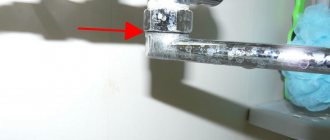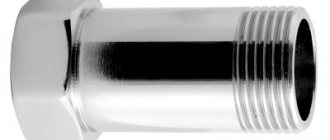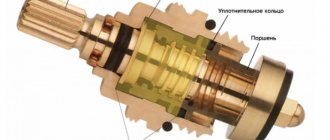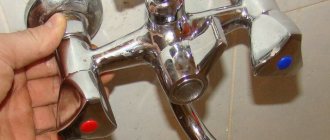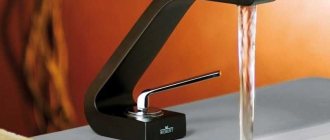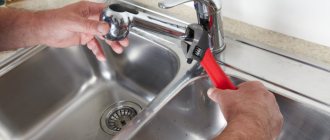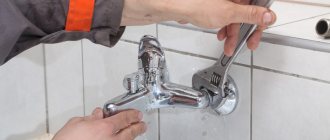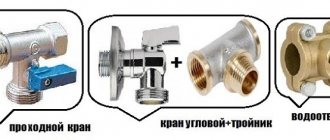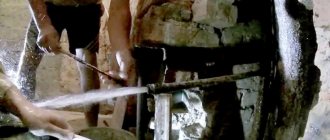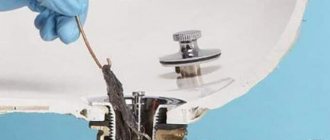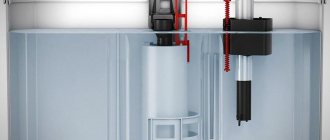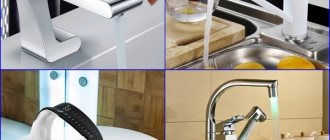The flexible hose does not want to unscrew; my husband has already worn it all out. How do you even unscrew this hose, and only one, if it’s even impossible to get caught there?
“doesn’t want to get out of it” - you just couldn’t convince him.
But seriously, it doesn’t really stick there, there’s nothing to rust, everything is brass. Therefore, there should not be any need for particularly Herculean efforts. I have exactly the same eyeliner, and I get there with a wrench. When I changed the sink and faucet, everything came loose (in 15 years, nothing really stuck).
If you crawled up to take a photo, then you can also get close with the key. By the way, judging by the state of the edges of the right hose, it can be assumed that they tried to unscrew it with a slightly larger wrench. And there, if my memory serves me correctly, you need an 11 mm wrench.
In the future, to make it more convenient to screw/unscrew, it is better to take hoses with edges spaced apart along the length:
There is something to grab onto. Hex nuts are turnkey, I don’t remember exactly how many, or 13 or 14. They are right under the lid. It’s difficult to get to, first the left one is unscrewed, then the right one, it’s more convenient. The hose itself is screwed into the mixer.
If it is not convenient to unscrew, then it is easier to unscrew the fastening of the entire mixer (a large nut or a crescent) and pull the mixer along with the hoses up, of course, if the length of the hoses allows. And it will be more convenient to unscrew it at the top.
Just don’t unscrew it by grasping the metal braid; there is a rubber hose underneath, it breaks easily from twisting and squeezing, and can then burst at the most inopportune moment.
The photo shows the thread that is screwed into the mixer and the turnkey nut.
All plumbing equipment is connected to water pipes using rigid or flexible hoses. Rigid hoses are less preferable, as they require higher precision during selection and do not allow the device to be moved in any direction. You can connect a flexible line to a faucet or other plumbing device yourself.
Connecting the mixer with flexible hoses
What is flexible eyeliner?
The flexible line is a hose protected by a special braid. On one side of the hose there is a crimp sleeve intended for connection to the mixer. On the other side there is a union nut complemented by a rubber gasket. A nut is used to connect the inlet to the outlet of the water pipe.
Components of flexible liner
The liner hose can be made:
For braiding the following can be used:
- aluminum. Hoses with aluminum braid are designed to pass water whose temperature does not exceed 80ºC. Working pressure no more than 5 atmospheres. The average service life of the product is 5 years. The main disadvantage of aluminum-wrapped hoses is their high susceptibility to corrosion when used in rooms with high humidity;
- stainless steel. The service life of such a product increases to 10 years. At the same time, the flexible liner can withstand water temperatures up to 95ºС and pressure up to 10 atmospheres;
Flexible hose with stainless steel braid
- nylon. The hose with nylon braid has a long service life (up to 15 years). Installation is possible at water temperatures up to 110ºС and pressure up to 20 atmospheres. The cost of such products is higher than other types;
How to change wall taps
Sometimes kitchen sinks are equipped with wall-mounted faucets. The advantage of this technology for installing a faucet is that it is attached directly to the water pipes.
There are two types of wall-mounted mixers: with pipes located in the wall (inside), and with their external location (on the surface).
Replacement technology:
- Block the water supply.
- Drain the water from the taps.
- Loosen the nuts holding the mixer.
- Attach the wall version using an adapter.
- After installing the fittings using rubber gaskets, secure the device with nuts.
- After tightly fixing absolutely all components of the new mixer, you need to open the shut-off valves and check the system.
Choice of eyeliner
If you need to replace the flexible hose, then first of all you need to choose the right hose to connect the mixer. When choosing, you need to rely on the following factors:
- purpose of the eyeliner. On sale you can find hoses for connecting cold and hot water, as well as universal products. The cold water liner is wrapped with blue thread. For hot water - red thread. The universal eyeliner has inclusions of both blue and red threads;
Connection suitable for connecting both cold and hot water
- hose parameters. When selecting parameters, it is necessary to determine the type of connection of the line to the mixer and water pipe (nut, fitting, etc.), as well as the type and size of the thread. Threads can be internal or external. Thread sizes range from ½” to 1 ½”. At the next stage, the length of the hose is selected. To make the connection as reliable as possible, it is necessary to eliminate the possibility of tension on the hose. To do this, you need to choose a device whose length is slightly greater than the distance from the mixer to drain the pipe;
- material for making fittings and nuts. Brass is more reliable and durable. Connecting elements can also be made of aluminum (over time, the material becomes rusty and becomes unusable) or plastic (highly susceptible to mechanical stress);
- the hose must be sufficiently elastic. If, when holding the hose by one end, the hose assumes a hanging position, then this indicator is normal. If the hose takes a horizontal position, then the elasticity of the product is small;
- there should be no visible damage on the winding, nuts and fittings, which will lead to a reduction in the service life of the product.
Answers from experts
Arkady Trubetskoy:
You take the key and unscrew it.
Cat's smile:
... It’s stuck - you have no other choice but to rip these off and throw them in the trash - by the protruding ends, with platypuses - you’ll turn them out. - Then you buy others with a LONG shank - for these particular options - you don’t need to tighten them much, the gasket is reliable - and unscrew it - the long shank allows...... Py. Sy. you can get creative and throw nylon clamps inside, tighten them and unscrew them - but the possibility is that this liner is unusable - 90%
Alexander Doronin:
Cut off the braided hose, leaving what remains to be tightened with pliers. choose a tubular wrench or a socket with thin walls
Hero of the day:
With a key.
Dmitry:
The faucet is not Oras? If Oras, then the thread on the eyeliner is left-handed: to unscrew it, you need to twist it clockwise. If you can’t do it by hand, then there is an internal hexagon in the eyeliner. Take out the cartridge and unscrew it using a Allen key.
Just a king:
Unfortunately, what we see in the photo is hopelessly thrown into the trash. Nothing can be fixed there anymore. Need a new faucet. The eyeliner can be left the same.
Cat Oddball:
Try heating it with boiling water from a kettle and immediately unscrew it until the internal thread warms up.
Ravshan Buzoev:
WD forty overnight or kerosene, then wrap it in a rag and twist it
Podzhopnikov (c):
What, the hot water was turned off?)
Volkov Vladimir:
take a rag
Alexander:
if it’s not shiny and doesn’t get damaged, you can tap the nut a little...
Cobweb:
Ask your neighbor for the key.
Alexey Zolotov:
we wrap two sticks on one side with a rope, we clamp them like with tongs - you can unscrew them, we clamp them according to the principle of the letter A - how the crossbar is clamped with its legs
Natalya Klemyatich:
Cut a groove in the stick to fit it and unscrew it
How to replace eyeliner
When replacement is necessary
It is necessary to change the hose if:
- The flexible line broke. Breakage of the braid or rupture of the internal hose will lead to the formation of a leak and, as a result, flooding of the room. The causes of leakage may be high pressure in the system or mechanical impact;
Loss of tightness of the connecting hose
- A flexible hose leak was detected at the junction with the mixer or water pipe. The causes of leakage may be natural wear of the gasket or a crack in the fitting (nut).
Leak at the hose connection
Flexible line replacement process
To install a flexible water supply to connect a mixer, you must:
- turn off the water supply. This can be done using a tap installed in the apartment;
- open the mixer taps to drain the remaining liquid;
- Using an adjustable wrench or a wrench corresponding to the diameter of the union nut, unscrew the hose from the water pipe. If the connection point is rusty and the hose does not unscrew, then you should not make any effort to remove the liner. In this case, a solvent or WD 40 liquid is applied to the rust, which removes plaque;
Disconnecting a flexible hose from a water pipe
- remove the mixer. To do this, it is necessary to loosen the nuts securing the device;
Places for fixing the mixer to the plumbing equipment
Installing flexible hoses on the mixer
- Attach the supply hoses to the outlet of the water pipe.
- When you turn on the water for the first time, it is recommended to check the flexible hose and connection points for leaks. The average inspection time is 20 – 30 minutes.
Answers from experts
Michael:
if you reach it, you need to use pliers to grab the rim around the hose under the mixer and unscrew it and buy one in the store, just not a cheap one, screw it back with your hands and pull it with pliers, but not very tightly (sometimes it’s enough to tighten it by hand and then screw it to the pipe with a wrench. don't pull too hard on the pipe, otherwise you will overtighten the nut and it will burst, perhaps not right away. But first unscrew it from the pipe, if the woman does not have an adjustable wrench, then you can use large pliers to grab the nut. PS, be sure to unscrew the nut, perhaps if the the water will flow slowly, make sure that the valve that shuts off the water doesn’t turn, and look at the condition of the pipes and valves, if they are rusty and don’t spin, then it’s better that Maria correctly said, don’t climb in yourself
Vitalban1:
Buy a new smestak - the higher its price, the quieter it works. All plumbing fixtures are designed to last for a maximum of 5 years, buy a new one rather than have to deal with this faucet in six months. the cartridge or axle boxes will be covered.
Maria:
Call a plumber, otherwise you will flood all your neighbors. But they unscrew it with a special wrench, and the diameter of the pipes is different, if you don’t go anywhere you don’t know, it will only cost more.
BOSS:
Key No. 11.GO!!! What's included in the mixer? Buy the same one you unscrewed...
Valery Golda:
turn off the water, choose a nag that is the right size, unscrew both hoses, buy the same ones and put them in place
Ermak Group:
Very simple. Unscrew the hoses only from the mixer side, and do not touch the pipe side.
kon mal:
It won’t work if thin pipes fit into the mixer. They don't spin.
gray-haired:
Experiments begin in the morning.. but the fact that there are basics of plumbing doesn’t matter!
Verethragna Mitra:
First you need to remove the faucet from the sink, otherwise it will be inconvenient. Well, on the merits of the question - there are hex fittings at the ends of the flexible hoses, use them to unscrew them
Arkady:
I'm sitting and laughing. Yeah, for the hexagons. Only two problems. It is difficult to get to them without removing the faucet from the sink. And second, how will you spin them? The nut, slightly loosened, begins to turn. Easy to unscrew. But the hexagons are tightly connected to the hose. You'll have to twist the hose. Most likely you will ruin it.
Minuses
Whatever one may say, there are some downsides here.
We noted that installation is a controversial issue, so it should also be considered a disadvantage. It is quite problematic to perform it, since you are limited in moving the eyeliner. Actually, this creates another drawback - stationarity. The product does not bend, and does not lend itself to even slight deformation, which would allow for a more correct, aesthetic installation.
Otherwise, even experienced specialists do not find any serious shortcomings that could characterize rigid eyeliner.
The types of rigid eyeliner can be classified based on the materials from which they are made in our time. It consists of metal tubes. This metal, in turn, can be:
Which option is more reliable is up to you to decide. This largely depends on the manufacturer and his degree of responsibility for his own products. The most important thing is that the metal has anti-corrosion properties and is not a cheap fake. Unfortunately, some companies use ordinary ferrous metal, which rusts over time. And to hide this fact, they cover it with special paints and compounds. As a result, the tubes look like steel, copper or brass.
Rigid connection for a Grohe faucet: you need to spread the pipes wider!
If the comments of domestic experts about the flexible Grohe hose send the writer Zadornov to smoke on the sidelines, then the forums on replacing or repairing the rigid hose for the Grohe faucet will simply make him cry. What is this passage worth?
Grohe hard eyeliner
- ... since the tubes in the liner are copper, that means they must bend! Slightly moved one apart relative to the other, and... the collet clamps with 1/2" outputs fell into place! - here you go, Düsseldorf engineer! You invent clever collets there, and we’ll just separate the pipes and all the clamps will fall into place!
I do not quote other comments on this topic. Search for yourself. There are countless of them.
Tips for choosing
When choosing a rigid liner for your faucet, try to follow a few simple rules. They are advisory in nature, but they allow you to make the right purchase.
- Material. Carefully study what material the eyeliner is made of. In fact, steel, brass and copper have their own advantages and some nuances, so the most important thing is the absence of counterfeiting. If you are told that it is brass, you must be sure of the truth of these words.
- Size. Hard eyeliner is a little problematic in that it requires the correct choice of size. You need to take into account the diameter of the water supply pipe and the inlet to the mixer. Some houses are equipped with non-standard communications, so be sure to take measurements before going to the store.
- Length. A separate topic for conversation. The bottom line is that you need to choose the right length. If the tube turns out to be short, you will have to buy a new one or weld the missing element, which is a solution for the most extreme cases. If the tube is long, you will not be able to fully install it, since the material does not bend. This is the main problem with choosing a rigid eyeliner.
- Manufacturer. Now the market has formed its own elite of manufacturers of plumbing fixtures and sanitary equipment. There is also probably a store in your city that enjoys the greatest authority. It is advisable to purchase products from them. Both the manufacturer and the distributor are not interested in losing credibility and customers. That's why they try to offer high quality products. This is exactly what you need.
- External aspects. As a rule, they try to hide the eyeliner from view by doing upholstery, installing bathroom furniture, and so on. But in some situations, the eyeliner remains visible, which means you have to pay attention to its design.
- Price. Let's just say one thing - a good hard-type eyeliner cannot cost a penny.
How to choose a shower hose?
In most cases, the hose is purchased at the construction market or in plumbing stores. What should you pay attention to? First of all, the length of the shower hose. This point is extremely important, because if the hose is small, swimming will be uncomfortable, and excessive tension is harmful for the hose itself. But if it is too long, it will get tangled and sag, and it will need to be wound into a small bay.
The standard dimensions of a shower hose are 1.25–2 m. The optimal hose length is 1.6 m; hoses of this length are suitable for most cabins and bathtubs of similar length. Obviously, this indicator is not a template, because for small baths hoses up to 1.25 m long are used, and for longer baths a hose of about two meters may be useful.
What material should a high-quality hose be made of? It is worth paying attention to the manufacturer. If you need a simple metal hose with corrugated braiding, then products manufactured by companies in Russia, the Czech Republic or China are suitable. These hoses contain a rubber tube with thin walls. This option is good for a bathroom faucet, but there is a problem - if the corrugation starts to unwind, its sharp edges can damage this tube so that it breaks.
Germany, known as a supplier of higher quality products, produces its hoses not in corrugation, but in a special silicone sheath. Such products last longer in the bathroom, are more durable and flexible, and therefore are not afraid of kinks.
Advice! It is forbidden to bend the hose too much and leave it in this position for a long time, because it is not designed for this.
The winding in the German hose has several layers, due to which it is not very susceptible to fractures and bends (repeat). Also, faucet hoses from Germany are often decorated with a metal braid or can be made of polymer without additives. The silicone hose is easy to clean from dirt because its surface is smooth. An opaque polymer hose would look best in the bathroom, because a hose with transparent walls over time gets a yellowish tint from the inside due to impurities contained in the water.
Installation
By following the sequence of installation work, you can easily connect the hard line to your mixer.
- Determine where to place the faucet.
- Prepare the wall for the subsequent installation of pipes. Mark special strips for placing pipes. Make a groove. Some tubes can run along the wall, others have a recess. Don’t forget, the system will have elbows, so first mark them on the wall.
- Assemble the pipes. Mostly, even experienced home craftsmen entrust this task to professionals. One way or another, do not forget to tighten the eccentric at this stage. No winding required yet.
- Secure the old faucet to ensure the system is positioned correctly. Don't worry, all faucet models have the same distance between the mounting points.
- If you understand that everything is done correctly and smoothly, proceed to sealing the grooves. For this you will need a cement mixture. Also provide a layer for subsequent application of finishing material (since this is a bathroom, most of us use ceramic tiles).
- When the cement mixture has dried, you can remove the old mixer and install a new one in its place.
- The final stage will be the treatment of the wall surface and installation of tiles. Make sure that all fasteners are tight so that there are no leaks during operation.
What tools and materials will be needed for replacement?
Dismantling and further installation of the device for a classic sink is carried out using plumbing tools.
You will need:
- wrench (10 x 12, 13 x 14);
- socket wrench (10 x 12, 13 x 14);
- brushes;
- sealing tapes (PTFE);
- pliers;
- flat screwdriver.
When solving the problem of changing or repairing a device, the master must have a complete installation kit. It is often sold complete with the device. It may include studs, nuts, and rubber half-washers.
How to put it instead of flexible
You can probably notice that flexible eyeliner is everywhere, in almost everyone’s home, office, and so on. It is easy to install and costs little.
But how many people know that it needs to be changed every 3-5 years?
This is caused by the fact that the liner gets old, the hoses inside it become cracked, the seals fail, and elasticity is impaired. As a result, leaks are almost inevitable.
In this component, the rigid analogue of the liner is more reliable, capable of working with higher pressure, and the service life is several times longer.
Experts recommend that when renovating a bathroom, provide for the possibility of connecting a rigid line in the future , even if you are currently planning to install a flexible one. Water outlets located under the sink should not be more than 0.5 m from the mixer. If this condition is not met, you can use an alternative solution - corrugated tubes. But they must be made of stainless steel.
Unscrew all the old pipes, dismantle the faucet and expand the corner taps. Screw the tubes into the mixer and make sure everything fits in place. If not, carefully unbend the product or mark points for cutting off excess elements.
Once you have adjusted the tubes to the required dimensions, check the axial relationship and assemble the system. The faucet is fixed to the sink first, after which the collets are tightened. Turn on the water and make sure everything is working properly. Also be sure to check the system for leaks after a few days. If there is decorative trim or furniture covering the system, do not install it yet. Only when you understand that everything is working properly, close the eyeliner.
How to unscrew a stuck faucet
Unscrewing the faucet nut may not be very easy. Rust, limescale, and scale may accumulate inside. To unscrew the faucet, you need to stock up on the right tools and patience. Tools must be an exact match in size and fit tightly. Before starting work, make sure that the tool has a firm grip on the part.
A stuck faucet is the most difficult to unscrew, since you will have to use careful, moderate force. Perform all actions to replace the mixer and unscrew the nuts smoothly, without jerking. Any sudden movements can lead to thread stripping or breakage.
How to prepare for changing your faucet
Prepare your tools and turn off the water. Make sure that the rotary plugs that shut off the water supply in the bathroom or kitchen are in good working order. To do this, after turning off the water supply, open the tap and carefully watch the meter.
It shouldn't spin. You cannot change or remove the faucet without turning off the water. There may be water left in the pipes; prepare a bucket or basin. During operation, the taps must be in the open position.
If you turn off a bathroom faucet, close the drain to avoid clogging with small construction debris.
List of tools for faucet removal:
- Adjustable wrench. If the faucet needs to be removed from the countertop, you will need 2 adjustable wrenches. You can use a set of keys 10, 11 and 22, 24.
- Comfortable work gloves with a waterproof and non-slip coating. Working with gloves is more effective than with bare hands due to better grip. Don't neglect work gloves.
- A hacksaw for metal is for extreme cases.
- Plumbing universal lubricant WD-40. This lubricant is called “liquid key” for its high penetrating ability and easy dissolution of limescale, rusty deposits, and paint layers.
- New flexible hose - liner. A standard hose, 30 cm long, is not always suitable. When replacing a faucet, it is better to change it along with the flexible hose.
- FUM tape. Required when re-tightening the nuts.
- Spare faucet - in case of breakage of shut-off valves.
If you are replacing a faucet, it will come with hardware. Make sure the new fasteners fit your plumbing fixtures. Make sure you have all the necessary fastening components in advance. Pay attention to the nut and bolt type fasteners. Or in common parlance “dad - mom”. The nuts on the fasteners must match the bolts and vice versa.
Operating procedure
- Provide access to the workplace. To do this, in some cases you will have to remove the sink. This is not a prerequisite, it’s just easier to get to the fastenings.
- Remove the bottom of the siphon under the sink so it is out of the way. At the same time, you can clean the siphon from semi-liquid dirt. It's best not to skip this step.
- Disconnect the hot and cold water supply hoses. They are fastened with 22 or 24 nuts. Unscrew counterclockwise. The hose fastening nuts usually unscrew without problems.
- Attach an adjustable wrench to the nut that secures the faucet under the kitchen sink countertop or under the sink. Use a second wrench to hold the faucet body at the top. If the case is chrome plated, use thick rubber pads and an adjustable wrench to hold the case tightly without damage. Apply multi-purpose grease for easy loosening. While holding the faucet body, carefully unscrew the nut from the bottom. It doesn't always work out on the first try.
Once the faucet is removed, you can begin replacing the faucet - the switch fitting that is used to supply water to the shower hose. The fittings are usually made of brass and are fragile.
Unscrew the bolt and inspect the rods. Pay special attention to plastic parts. High-quality faucets have a ceramic base inside. Most often, faucet leaks and a characteristic squeak in the pipes due to a pressure drop are caused by wear of the seal. Replace the winding and readjust the clamping bolt.
Ways to unscrew a stuck nut
- You can try soaking a stuck nut with WD-40 or regular kerosene. Apply grease to the nut and let the grease soak in for about 10 minutes and try again. If that doesn't work, try repeating the lubrication.
- You can remove stuck reinforcement by heating it. A construction hair dryer heats up the case, while continuing to try to unscrew the locking fittings.
- The barbaric method consists of trying to tap the stuck fragment, like tapping a threaded tin can with a spoon. Gently but firmly tap the nut with a hammer in the direction of twisting, counterclockwise. The situation is complicated by the fact that corrosion eats away at the metal, making it brittle. Don't skimp on lube.
If the thread is damaged, a crack or break appears, the damaged faucet will have to be thrown away. If only the faucet is damaged, it can be replaced.
If the mixer has become thoroughly stuck, a piece of thread has broken off and no attempts to unscrew the nuts help, the nut is simply cut off with a circular saw or a hacksaw.
Conclusion
Use high-quality plumbing fixtures, or replace broken parts and faucets without regret. Do not try to save broken pieces of a Chinese faucet, especially in a house with water meters. It is better to change the switching fittings, in particular the valve axle, entirely and at once. An attempt to save ten rubles can result in colossal expenses when your neighbors are flooded.
Boot repair video:
Video analysis of the crane boots:
uchieto.ru
Rigid connection for a Grohe faucet: you need to spread the pipes wider!
If the comments of domestic experts about the flexible Grohe hose send the writer Zadornov to smoke on the sidelines, then the forums on replacing or repairing the rigid hose for the Grohe faucet will simply make him cry. What is this passage worth?
Grohe hard eyeliner
- ... since the tubes in the liner are copper, that means they must bend! Slightly moved one apart relative to the other, and... the collet clamps with 1/2" outputs fell into place! - here you go, Düsseldorf engineer! You invent clever collets there, and we’ll just separate the pipes and all the clamps will fall into place!
I do not quote other comments on this topic. Search for yourself. There are countless of them.
